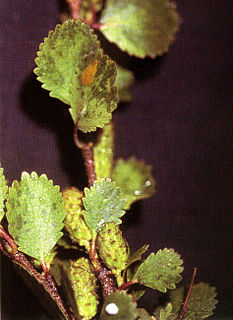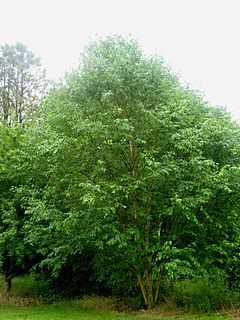
A birch is a thin-leaved deciduous hardwood tree of the genus Betula, in the family Betulaceae, which also includes alders, hazels, and hornbeams. It is closely related to the beech-oak family Fagaceae. The genus Betula contains 30 to 60 known taxa of which 11 are on the IUCN 2011 Red List of Threatened Species. They are a typically rather short-lived pioneer species widespread in the Northern Hemisphere, particularly in northern areas of temperate climates and in boreal climates.

Betula pendula, commonly known as silver birch, warty birch, European white birch, or East Asian white birch, is a species of tree in the family Betulaceae, native to Europe and parts of Asia, though in southern Europe, it is only found at higher altitudes. Its range extends into Siberia, China, and southwest Asia in the mountains of northern Turkey, the Caucasus, and northern Iran. It has been introduced into North America, where it is known as the European white birch, and is considered invasive in some states in the United States and parts of Canada. The tree can also be found in more temperate regions of Australia.

Betula pubescens, commonly known as downy birch and also as moor birch, white birch, European white birch or hairy birch, is a species of deciduous tree, native and abundant throughout northern Europe and northern Asia, growing farther north than any other broadleaf tree. It is closely related to, and often confused with, the silver birch, but grows in wetter places with heavier soils and poorer drainage; smaller trees can also be confused with the dwarf birch.

Betula nigra, the black birch, river birch or water birch, is a species of birch native to the Eastern United States from New Hampshire west to southern Minnesota, and south to northern Florida and west to Texas. It is one of the few heat-tolerant birches in a family of mostly cold-weather trees which do not thrive in USDA Zone 6 and up. B. nigra commonly occurs in floodplains and swamps.

Betula papyrifera is a short-lived species of birch native to northern North America. Paper birch is named for the tree's thin white bark, which often peels in paper like layers from the trunk. Paper birch is often one of the first species to colonize a burned area within the northern latitudes, and is an important species for moose browsing. The wood is often used for pulpwood and firewood.

Betula nana, the dwarf birch, is a species of birch in the family Betulaceae, found mainly in the tundra of the Arctic region.

Betula populifolia is a deciduous tree native to eastern North America.

Beaucarnea recurvata, the elephant's foot or ponytail palm, is a species of plant in the family Asparagaceae. The species was native to numerous states of eastern Mexico but is now confined to the state of Veracruz. Despite its common name, it is not closely related to the true palms (Arecaceae). It has become popular in Europe and worldwide as an ornamental plant. There are 350-year-old Beaucarneas registered in Mexico.

Betula pumila is a deciduous shrub native to North America. Bog birch occurs over a vast area of northern North America, from Yukon in the west to New England in the east and all the way to Washington and Oregon, inhabiting swamps and riparian zones in the boreal forests.

Abies recurvata is a species of conifer in the family Pinaceae. It is found only in China. Abies recurvata is a distinct fir species usually recognized by the needles on its leaders mostly recurved or reflexed. It occurs in the drier, colder northern regions of central China in Sichuan and Gansu provinces at elevations between 2300 and 3600 m, usually on windy cliffs or in deep river valleys. Sometimes, however, also appears in dry low scrub on exposed mountain slopes. The most typical associated conifer species include Juniperus convallium, Juniperus formosana var. mairei, Juniperus squamata var. fargesii, Juniperus tibetica, Picea asperata, and Picea wilsonii. Abies recurvata is a small to medium-sized tree mostly with conical crown, occasionally reaching a height of 40 m, and a trunk diameter of 0.8 metres. It has rather smooth gray or rusty brown bark, at first shedding in thin plates, becoming grayish-brown and detaching in thick plates. The branchlets are grayish-white or light yellow with 1.2–2.5 centimetres (0.47–0.98 in) long needles horizontally outspreading on shade branches, radially outspreading on fertile branches; often thick and recurved, green to gray above and densely set with stoma-lines, with 2 light grayish-green stomatal bands below. Abies recurvata has 4–8 centimetres (1.6–3.1 in) long ovoid or cylindrical-ovoid, gray- or purplish blue cones; the bracts are somewhat shorter than the cone-scales, included or with slightly exposed tips.
Betula halophila is a species of plant in the Betulaceae family. It is endemic to China.

Betula raddeana is a species of plant in the Betulaceae family. It is found in Georgia and Russia. It is threatened by habitat loss.
Betula szaferi is a proposed species of plant in the Betulaceae family, but it is otherwise a local form of Betula pendula. It would have been endemic to Poland. No wild subpopulations are presently known, but there is a specimen planted in Kraków Botanical Garden.

Betula uber, Virginia round-leaf birch, is a rare species of tree in the birch family. One of the most endangered species of North American trees, it is endemic to Smyth County, in the U.S. state of Virginia. It is part of the temperate broadleaf and mixed forests biome.
Stellaria recurvata is a species of plant in the family Caryophyllaceae. It is endemic to Ecuador. Its natural habitat is subtropical or tropical high-altitude grassland.

Betula cordifolia, the mountain paper birch is a birch species native to Eastern Canada and the Northeastern United States. Until recently it was considered a variety of Betula papyrifera, with which it shares many characteristics, and it was classified as B. papyrifera var. cordifolia (Regel) Fern.

Betula humilis, known in English as the shrubby birch, is a species of birch that can be found in Europe and Asia. The species has ovate leaves that are 1.2–3.5 centimetres (0.47–1.38 in) long and is related to Betula fruticosa.
Betula michauxii, the Newfoundland dwarf birch, is a species of birch which is native to Newfoundland, Nova Scotia and Quebec as well as Saint Pierre and Miquelon.

Betula grossa, commonly known as Japanese cherry birch, is a species of birch native to Japan, where it grows naturally in mixed woodland on hill and mountain slopes in Honshu, Shikoku, and Kyushu. It was introduced to the West in 1896, but remains rare in cultivation.















